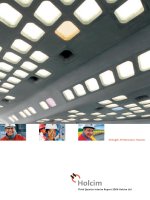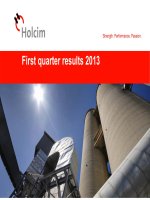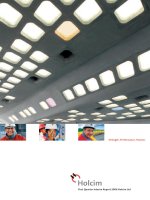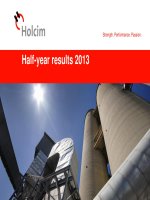holcim strength performance passion technical manual cement concrete holcim vietnam ltd 1st edition 2013
Bạn đang xem bản rút gọn của tài liệu. Xem và tải ngay bản đầy đủ của tài liệu tại đây (11.14 MB, 104 trang )
Holcim (Vietnam) Ltd.
1
st
edition 2013
Cement & Concrete
Technical Manual
Strength. Performance. Passion.
2
3
Copyright
C2013, Holcim (Vietnam) Ltd
All rights, including the partial re-print of parts or
entire section of the book in Vietnamese version
and/ or English version (including photo copy, micro
copy, CD-Rom, or any other way of copying and
presenting it in public), the storage in date centers
and the translation, are reserved to the authors.
Special permission must be requested in writing to
Holcim (Vietnam)
Authors
Technical consultant team
Holcim (Vietnam) Ltd
A special thank to Silvia Vieiria Mcs, PhD – Holcim
Group Support Ltd
Publication
1st edition 2013 in Vietnamese
1st edition 2013 in English
Disclaimer
Alone the complete standards referred hereto serve
as reference. They can be sourced at the respective
organizations. Holcim (Vietnam) is not liable for
misapplication and/or interpretation of the content
of this manual.
Imprint
4
5
About Holcim (Vietnam) Ltd.
Founded in 1912 in the tiny Swiss village of Holderbank, Holcim is
one of the world leading cement and construction materials
companies. Holcim operates in more than 70 countries across all
continents and employs around 90,000 people world-wide. Today
Holcim has become synonymous of leadership in the supply of
cement and aggregates (crushed stone, sand and gravel), as well as
readymix concrete and construction-related services.
Holcim (Vietnam), founded in 1993, has the unique network of 4
cement plants in south Vietnam at Hon Chong, Hiep Phuoc, Cat Lai,
Thi Vai, to guarantee the best supply security for each project. To
meet the requirements of every application, Holcim Vietnam has
researched and developed a wide range of cements that offer the
optimal solution for every project.
Established in 2005, Holcim Beton has developed into a leading
readymix supplier in southern Vietnam, offering its customers high
quality, innovative products and services. Over the last years,
Holcim Vietnam has worked with leading national and
international contractors and developers as the preferred partner in
projects in southern Vietnam.
6
7
Preface
To develop Vietnam in the 21
st
century and to meet the requirements of modern society, many high rise
buildings and infrastructure projects, like ports, roads, bridges… are being designed and constructed by
national and international developers, designers and contractors.
These structures are expected to be in service for long time, sometimes for 100 years, with low maintenance
costs. The durability of concrete as building material is a key element for long lasting projects. This Technical
Manual offers an overview of good practices in concrete as well as an overview of relevant Vietnamese and
international standards.
A better understanding of cement/concrete standards can make it easier for designers, consultants and
contractors to choose the type of cement and concrete, suitable for their specific project. With good concrete
practice at the jobsite, the high quality building material “concrete” will be molded and transformed into
long lasting concrete structures, to build Vietnam for future generations.
As the different standards are complex to summarize and the construction industry changes quickly in
Vietnam, it is possible that there are inaccuracies in this Technical Manual. We are looking forward to any
feedback or input for improvement on
Yours sincerely,
Pieter Keppens
Technical Marketing Manager
8
Index
Chapter I
Cement & Concrete 11
A. Components of concrete 11
1. Cement 11
2. Mixing water 12
3. Fine aggregate 13
4. Coarse aggregate 14
5. Admixtures 16
6. Additions 17
B. From fresh concrete to hardened concrete 20
1. Composition of concrete 20
2. Workability 23
3. Concrete strength 27
4. Special characteristics 33
5. Production and transport 37
6. Placing and compaction 38
7. Concreting in hot weather 41
8. Pumped concrete 43
9. Curing 45
10. Influence of formwork 47
Chapter II
Applications with specific requirements 49
A. Infrastructure 49
1. Introduction 49
2. Cement for infrastructure 49
B. Aggressive environments 50
1. Introduction 50
2. Sulfate resistant Portland cement 50
3. Sulfate resistant blended cements 51
C. Massive structure 52
1. Introduction 52
2. Cement for massive structures 52
3. Concrete for massive structures 53
D. High strength concrete 54
1. Introduction 54
2. Production and use of high strength concrete 55
E. Very flowable and self-compacting concrete 56
1. Introduction 56
2. Production of very flowable / self-compacting concrete 57
F. Cement treated aggregates 58
1. Introduction 58
2. Cement for treated aggregates 58
3. Testing procedure for cement treated aggregates 59
4. Optimization of cement treated aggregates 61
9
Chapter III
Causes and prevention of concrete defects 62
A. Segregation of concrete 63
B. Cracking 64
1. Plastic settlement cracks 65
2. Plastic shrinkage cracks 66
3. Surface crazing 67
4. Drying shrinkage cracks 67
5. Early thermal cracking 68
C. Carbonation and corrosion of reinforcement 69
D. Degradation in seawater environment 70
1. Chloride-induced corrosion of the steel reinforcement 70
2. Attack by sulfates from seawater 71
3. Preventive measures 71
E. Chemical attack 72
1. Classification 72
2. Preventive measures 73
F. Alkali – Aggregate Reaction 74
G. Fire Resistance 75
1. Concrete in fire 75
2. Preventive measures 75
Chapter IV
Overview of cement & concrete standards 76
A. Cement 77
Vietnamese standards – TCVN 77
American standards – ASTM 83
European standards – EN 86
B. Concrete 89
Vietnamese standards – TCVN 89
American standards – ASTM 91
European standards – EN 93
British standards – BS 95
C. Recommendation for limiting values of concrete composition 97
Chloride - induced corrosion in sea water 97
Aggressive chemical environments 97
Reference 98
10
11
1. Cement
General
Cement is a hydraulic binder – a material that
hardens after being mixed with water, either in the
air or under water. The hardened cement paste is
water-resistant and possesses high strength. For
all concrete without specific requirements, the type
of cement generally used in Vietnam is a blended
Portland cement, type PCB 40, according to the
Vietnamese standard TCVN 6260. For plaster/mortar
in rural areas, PCB30, a lower strength class, is
sometimes used as well.
Several types of blending materials are used, like
limestone, puzzolan or slag, depending on the locally
available materials.
International standards, comparable to TCVN 6260,
are:
• American Standard ASTM C1157: type GU
(General Use)
• European Standard EN 197-1: CEM II/A or CEM
II/B 42.5
Other types of cement, which are used worldwide, like
• Ordinary Portland Cement OPC (TCVN 2682,
ASTM C150, EN 197-1 CEM I)
• Blast Furnace Slag cement (TCVN 4316, ASTM
C1157, EN 197-1 CEM III)
are not available in Vietnam as general use cement.
The test methods of the TCVN standard are very
close to the EN standard, with the correction of
testing temperature (27
o
C instead of 20
o
C), to take
the local climate conditions into account.
The ASTM standards use a completely different
set of testing methods and the requirements
cannot be compared to the TCVN/EN standards. In
Vietnam, several 3
rd
party laboratories are equipped
to test cement according to TCVN & ASTM, but not
according to the EN standard.
Testing cement quality and conformity
The quality and conformity of Vietnam cements are
assured through three types of control:
• Control of the product in the plant
• An certified quality-management system
• External monitoring
Control of the product in the plant
At each step of the cement production, from the
quarry to cement delivery, material specimens
are collected for analysis. Gap-free monitoring of
production ensures uniform, high-quality cement.
The testing methods for cement are described in
standard TCVN 6017:1995 and ISO 9597:2008.
Quality management system
Most cement plants have established a quality
management system and all are certified according
to the ISO 9001:2008 series of standards. Some
cement plants also have a testing center in series of
VILAS according to ISO 17025. This ensures that all
operational processes are standardized, traceable,
and transparent.
External monitoring
In-house testing is supplemented by external
monitoring. External monitoring is carried out by a
testing institute accredited for testing cement. In the
south part of Vietnam, the most referenced external
monitoring is Quality Assurance and Testing Center 3
(QUATEST 3). From November 2012, every cement in
Vietnam has to carry the CR quality label.
Cement storage and shelf life
If cement is stored unprotected for a long time, it
absorbs moisture, which leads to lumps and may
reduce the strength development. If lumps can be
crushed between the fingers, the loss of strength
will be negligible.
Cement can be stored for a limited time in silo or
bags. Bag cement is best stored in dry shelter. Bags
stacked temporarily outdoors must be placed on
timber sleepers for ventilation. The plastic cover
must not be allowed to contact the cement bags,
because condensation would wet the bags.
Chapter I: Cement & Concrete
A. Components of concrete
Holcim recommendation
For general use concrete, standard cement offers
the best supply security for any project:
• TCVN 6260:2009 – PCB 40
• ASTM C1157:2008 – GU
12
2. Mixing water
Water for mixing concrete and mortar must comply
with TCXDVN 302:2004 or ASTM C1602. Water that
meets these requirements, can be used for washing
aggregate and curing concrete sample. According to
these standards, drinking water can be used as
mixing water without testing. Water from rivers and
canals is in most cases not appropriate to make
concrete. The use of seawater in reinforced concrete
is strictly forbidden.
General
Mixing water is the total amount of water contained
in fresh concrete. It is the sum of:
• The water added directly to the mix
• The surface moisture of the aggregates
• The water content of the concrete admixtures
and additions, if applicable
(silica fume, pigment in suspension, etc.)
Mixing water has two functions in concrete
technology. It is required for hydration of the
cement, and for the production of a plastic concrete
that can be well compacted.
Requirements for mixing water
According to TCXDVN 302:2004, mixing water must
meet these following requirements:
• Does not contain oil scum and oily film
• Organic content < 15mg/l
• 4 < pH < 12.5
• Color free
• Depending on the type of concrete, sulfate and
chloride content must follow the requirements
in Table I.1 (TCXDVN 302 : 2004).
Chapter I: Cement & Concrete A. Components of concrete
Table I.1 - Limit sulfate and chloride content in mixing water for different purpose
Purpose of mixing water
Maximum Level
(mg/l)
Soluble
Salt
Sulfate Ion
(SO
4
-
2
)
Chloride Ion
(Cl-)
Insoluble rest
1. Pre-stressed concrete. 2000 600 350 200
2. Reinforced concrete. 5000 2000 1000 200
3. Non-reinforced concrete. 10000 2700 3500 300
13
Chapter I: Cement & Concrete A. Components of concrete
3. Fine Aggregate
Grading
Fine aggregate shall consist of natural sand, crushed
sand, or a combination thereof. For concrete
production, fine aggregates must comply with TCVN
7570 : 2006 or ASTM C33 (Standard Specification for
Concrete Aggregates). In the south of Vietnam, 3
sources of fine aggregates are used in concrete (FM
= fineness modulus):
• Sand from Dong Nai river : FM = 2.40 (good – not
available in significant quantity)
• Sand from Mekong river : FM = 1.1 -1.6 (too fine)
• Manufactured (crushed) sand : FM = 4.0 (too
coarse)
Usually when the sand is very fine, the mix is
un-economical because the increase of water
demand will lead to the increase of cement. When it
is very coarse, the mix is harsh and unworkable
because there are so much voids between the grains
and the cement paste can not fill the voids.
According to ASTM C33, a reference for good sieve
curve of fine aggregates for concrete is like Fig I.1.
In the south of Vietnam, sand compliant to ASTM
C33 cannot be found. The current practice is to
combine Mekong sand with manufactured sand, to
reach the best performance.
Organic Impurities
Fine aggregate must be free of deleterious amounts
of organic impurities. Fine aggregates that contains
many organic impurities, will lead to delay in
concrete setting, loss of strength and durability of
concrete.
Fine aggregate should be tested before use on
organic impurites according to standard TCVN
7572-9 : 2006 or ASTM C40 (Standard Test Method
for Organic Impurities in Fine Aggregates for
Concrete). When a sample has a color darker than
the standard color, or Organic Plate No. 3, the fine
aggregate under test contains possible injurious
organic impurities. It is advisable to perform further
tests before approving the fine aggregate for use in
concrete.
Other Impurities
Impurities like silt, dust, clay content also have a
disavantage effect on concrete. It should be tested
before use for concrete according to standard TCVN
7572-8 : 2006 (Standard test method for silt, dust,
clay content) or ASTM C117 (Standard Test Method
for Materials Finer than 75-μm).
Akali-Silica Reaction
For concrete that is subjected to wetting, extended
exposure to humid atmosphere, or contact with
moist ground (for example, foundations, bridges,
tunnels,…), the aggregates (both fine and coarse)
shall not contain any materials that are deleteriously
reactive with the alkalies in the concrete to cause
Alkali Aggregate Reaction. This expansive reaction
can create cracks in the concrete, which reduces
both the concrete strength and the durability.
Potential Alkali-Silica Reactivity of Aggregates
should be tested according to standard TCVN 7572-
14:2006 (Determination of alkali silica reactivity ) or
ASTM C289 (chemical method), ASTM C1260 or
ASTM C227 (mortar – bar method).
Fig I.2
Organic
impurities test
using organic
plate.
Fig I.1 - Good sieve curve of fine aggregate for concrete
10
0
20
30
40
50
60
70
80
90
100
9.50
10.0 1.0
Sieve openings (mm)
Fine limit (ASTM C33)CombinationCoarse limit (ASTM C33)
Passing (%)
0.1
4.75 2.36 1.18 0.60 0.30 0.15
Manufactured sand
Mekong sand
14
4. Coarse aggregate
General
Coarse aggregates form the skeletal structure of the
concrete and must comply with TCVN 7570 :2006 or
ASTM C33 (Standard Specification for Concrete
Aggregates).
Characteristics
The most important characteristics of coarse
aggregates are:
• Specific gravity
• Bulk density (unit weight) and moisture content
• Mineral composition, grain shape, and surface
texture
• Purity
• Grading (grain size distribution) and aggregate
fractions (range of sizes)
• Soundness
Table I.2
Classification of
aggregates by
specific gravity
State Ovendry Air dry
Saturated surface dry
(SSD)
Damp or wet
Total moisture None
Less than potential
absorption
Equal to potential
absorption
Greater than
absorption
Fig I.3
The moisture
state of
aggregate
Bulk density (unit weight) and moisture content
Bulk density is the weight of loosely poured material
per unit of volume. It is greatly influenced by
moisture content of the aggregate (Fig I.3). Thus the
two characteristics, bulk density and moisture
content, are closely related. Test method of bulk
density according to TCVN 7572-6 : 2006 or ASTM
C29 (Standard Test Method for Bulk Density and
Voids in Aggregate).
The moisture state of aggregates can change
between ovendry and wet aggregates, depending on
the situation.
Specific gravity
The aggregate specific gravity is the ratio of the
weight of a given volume of aggregate to the weight
of an equal volume of water. Aggregate specific
gravity is needed to determine weight-to-volume
relationships and to calculate various volume-
related quantities such as voids in mineral
aggregate. The test standard for coarse aggregate
specific gravity and water absorption is the TCVN
7572-4 : 2006 or ASTM C127 (Determination of
apparent specific gravity, bulk specific gravity and
water absorption).
Aggregate type Specific Gravity (kg/m
3
) Aggregate Material Application
Standard aggregate 2700
River or glacial deposits;
crushed stone
Reinforced and
non-reinforced concrete
Heavy aggregate >3000
Barite (heavy spar), iron ore,
granulated steel
Concrete for radiation
protection
Lightweight aggregate < 2000 Expanded clay, polystyrene
Insulating concrete, concrete
topping, sloped concrete
Hard aggregate > 2500
Quartz, corundum, silicon
carbide
Hard concrete slabs,
abrasion-resistant concrete
Chapter I: Cement & Concrete A. Components of concrete
15
Purity
Adhesive impurity on coarse aggregate surface, such
as dust from degraded rock, reduces concrete
quality, for example, by disturbing setting properties
and reducing the contact area between aggregate
and cement paste. It is suggested to wash coarse
aggregate before use in concrete (Fig I.4.).
Grading
The grading and maximum size of coarse aggregate
is an important parameter in concrete mix. The
grading of aggregate is measured according to
TCVN 7572-2 or ASTM C136 (Standard Test Method
for Sieve Analysis of Fine and Coarse Aggregates)
Grading, or the distribution of grain sizes – along
with surface texture, specific surface, and grain
shape of coarse aggregate – greatly determines the
water requirement, and thus is one of the most
important characteristics.
The maximum size of aggregate (D
max
) is the
smallest sieve size, through which at least 90% the
aggregate would pass. The maximum size of
aggregates is limited by the application. It depends
on: the distance between reinforcement, size of
elements, and pumpability of concrete. The choice
for maximum size of aggregate follows the Fig I.5.
The use of smaller aggregates increases the water
demand, increases the cement content to meet the
same strength.
Mineral quality, grain shape, and surface texture
Porous or overly soft aggregate (for example
degraded rock) impairs the quality of concrete. Grain
shape largely determines the compactability and
water requirement of concrete, as does grading and
surface texture (Fig I.6).
A cubical grain shape is good for concrete mix, it
decreases the water requirement and increases
workability of concrete. In contrast, non-cubical,
grain shape (elongated and flaky- aggregate
particles having a ratio of length to thickness
greater than a specified value) will increase water
demand and decreases the workability of concrete.
Non-cubical grain shape content is measured
according to TCVN 7572-13 (Determination of
elongation and flakiness index of coarse aggregate).
Fig I.5 - The choice for maximum size of aggregate
Fig I.6
Grain shapes of
aggregate
Rounded Irregular Angular
Desirable
Less Desirable
Flaky
Elongated
Flaky Elongated
Fig I.4 - Screening and washing aggregate in a gravel plant
I-
D
max
< 3d/4
D
max
< e/5
D
max
< f/5
D
max
< a/3
D
max
< 1/3 diameter of hose
or 37.5mm
For pumped concrete
c
f
c
e
a
d
d
D
max
< 3c/4
II-
III-
IV-
Chapter I: Cement & Concrete A. Components of concrete
16
5. Admixtures
Definition and classification
Concrete admixtures are chemical substances that
are added to concrete to change, through chemical
and/or physical action, some of its properties, such
as workability, setting, hardening.
In Vietnam, the performance requirements for
different types of admixtures comply with standards
TCVN 8826 : 2011 or ASTM C494 (Standard
Specification for Chemical Admixtures for Concrete).
Dosage
Admixtures are added to concrete mainly in liquid
form and in very small amounts. The dosage is
generally about 0.4 to 2% in relation to the weight
of cement. In certain cases the amount will be
recommended by the manufacturer. If the dosage
exceeds about 1%, the water introduced with the
admixture, must be considered as part of concrete
mixing water. Too low dosage can reduce
significantly the desired effect, and too high dosage
can produce unwanted effects such as retarded
setting or loss of compressive strength.
The most important and common types of
admixtures
According to ASTM C494, there are seven types of
admixture (from type A through type G). In Vietnam,
three types are commonly used:
a/ Water reducing and retarding admixture.
This type of admixture, based on lignosulphonate,
can be used at dosage 0.4 - 0.6% to reduce the
quantity of water required (6% - 12%).
Water reducing admixtures require less water to
make a concrete of equal slump which improves the
concrete strength, or increase the slump of concrete
at the same water content.
Retarding admixture is useful for concrete that has
to be transported over long distances, requires a
long slump retention and to retard the setting time
of concrete when placed at high temperatures.
b/ Mid-range water reducing admixture.
This type of admixture, based on napthalene
sulfonate, can be used at dosage 0.7 – 1.2% to
decreases the water requirements by about 15
– 25%.
Mid-range water reducers allow larger water
reduction to increase strength or slump/slump
retention at jobsite. They can achieve a specific
consistency and workability at a greatly reduced
amount of water. As with most types of admixtures,
napthalenes can significantly delay the initial setting
time of concrete, depending on the admixture
formulation.
c/ High-range water reducing admixture
This type of admixture is based on polycarboxylate
base. Common dosages are between 0.8 – 1.8%,
depending on the supplier recommendation. This
type of admixture can reduce the quantity of mixing
water required (20 - 35%) to produce concrete with
high consistency, better workability and high
strength. The optimal dosage needs to be
determined based on the particular concrete mix
and specific requirements.
Other type of admixtures
Many other types of admixture for concrete are
available:
• Accelerators
• Air entrainer admixture
• Corrosion inhibitor
These specific admixtures are rarely used in
Vietnam. More information can be found from
different admixture suppliers.
Fig I.7 - Admixture used in concrete.
Chapter I: Cement & Concrete A. Components of concrete
17
6. Additions
Fibers
Polypropylene fibers are organic fibers, used in
concrete to prevent plastic shrinkage cracks. About
0.7kg - 1kg of fibers is required per m
3
of concrete
(Fig I.8).
Steel fibers, uniformly distributed in concrete,
improve certain mechanical characteristics,
particularly ductility (toughness) and tensile
strength. The efficiency of steel fibers greatly
depends on their length, diameter, and shape. The
main use of steel fibres is in industrial floors, to
replace the steel mesh in the concrete (Fig I.9).
Glass fibers are used to reinforce thin prefabricated
sections. Using glass fibers is tricky; it requires the
experience of a recognized expert (Fig I.10).
Silica fume
Silica fume (Fig I.11), also known as silica dust or
microsilica, possesses a high pozzolanic activity due
to extreme fineness and very high amorphous silica
content. Silica fume dosages of 5 to 10% by weight
of cement can produce permanent improvement of
concrete characteristics:
• Reduction of concrete porosity, thus
improvement of durability; increased resistance
to salts, sulfates, and other aggressive chemicals.
• Carbonation progresses slower, thus
reinforcement is better protected against
corrosion.
• Contributes to concrete strength; allows the
production of high-strength concrete
(80-100MPa)
Fig I.8
Polypropylene
fibers
Fig I.9
Steel Fiber
Fig I.10
Glass fiber, cut
and bundled
Fig I.11
Silica fume
Caution
Adding silica fume to a concrete mix reduces
the workability and changes the rheologic
characteristics (flow characteristics)! Adequate
workability can be achieved by adding special
superplasticizers.
As silica fume is very fine, the homogeneous
distribution into the concrete is an important
issue that requires specific attention. If the silica
fume is not well distributed into the concrete,
its efficiency in increasing strength and
durability will be reduced.
Chapter I: Cement & Concrete A. Components of concrete
18
Other mineral additions (puzzolan, fly ash)
In many countries, high quality fly ash, a by product
from thermo power plants, is commonly used in
concrete, as this is an active puzzolan that
contributes to the strength of the concrete.
In Vietnam, the use of both puzzolan (Fig I.12) and
fly ash (Fig I.13) is mainly limited to Roller
Compacted Concrete (RCC) in hydraulic dams. The
available fly ash is not suitable for flowable
concrete, due to its:
• High loss of ignition (= unburned coal)
• High water demand
• Issues with admixture compatibility
• Unstable quality, with limited quality control.
Inorganic pigments
Inorganic pigments are used to dye concretes and
mortars (Fig I.14). Oxide pigments are virtually the
only ones that can meet the demanding criteria of
stability and grading. Pigments have no chemical
effect on concrete. Because of their high fineness,
they increase the concrete water demand. This can
be counteracted by adding a highrange water
reducer. Pigment dosage, usually a few percent
measured by weight of cement, depends on the
desired color intensity. Amounts are recommended
by the suppliers.
Producing flawless colored concrete surfaces
requires great experience. Uniformly colored, bright
concrete surfaces can be achieved only with a
completely homogeneous concrete mix using white
cement and light colored sand. The color of the
gravel is not so important.
Any residue of colored concrete must be completely
removed from mixers, transport vehicles, and
conveyor equipment, so that subsequent batches of
concrete are not contaminated. Even the best
pigments cannot prevent the color of concrete from
fading somewhat over time.
Fig I.14 - Concrete products made using white portland
cement colored with pigments
Fig I.12
Puzzolan
Fig I.13
Fly Ash
Chapter I: Cement & Concrete A. Components of concrete
19
Cement & Concrete Concrete component
20
B. From fresh concrete to
hardened concrete
1. Composition of Concrete
Concrete is a composite material that consists
essentially of fine and coarse aggregates, glued
together by the cement paste. Aggregates occupy
60-75% of the concrete (measured by weight or by
volume, as Fig I.15 and they are important
constituents from a technical and economical point
of view. Aggregates play a central role in concrete
strength and durability.
But the picture looks a bit different when we
consider the so-called internal surface area, that is,
the combined surfaces of all the particles in
concrete. Measured in this way, the dominant
component in concrete is clearly cement and the
cement paste is fundamental in defining many
concrete characteristics.
Concrete mixing
In proportioning the constituents of concrete, or
determining the so-called concrete mix or mix
design, the producer is primarily concerned with
optimizing concrete's:
• Workability
• Strength
• Production cost
• Durability
Importance of the water/ cement (w/c) ratio
A central characteristics of concrete, and one that
largely determines its performance, is the water/
cement ratio, or w/c ratio (Fig I.16).
The relationships between the w/c ratio and
required characteristics of concrete are well known
in practice. Thus, the designing engineer usually
specifies the w/c ratio when he specifies the type of
concrete.
Fig I.15 - Composition of Concrete
Fig I.16 - Influence of the w/c ratio on concrete properties
21
Choosing the water/cement ratio
An appropriate w/c ratio will depend primarily upon
environmental exposure and the loads the concrete
construction will be carrying (Fig I.17).
Recommended maximum w/c for different exposure
conditions are given, for example, in the EN 206 or
in ACI 318.
Minimum cement content in concrete
With sufficient cement in concrete, enough calcium
hydroxide is formed during hydration that the high
alkalinity and low porosity achieved in the concrete
will reliably protect the steel reinforcement from
rusting. On the other hand, overly large amounts of
cement in concrete increases the possibility of cracks
due to shrinkage and increased heat of hydration.
According to EN 206, reinforced concrete with a
maximum aggregate size of 32mm should normally
contain at least 300kg cement per m
3
compacted
concrete. The dosage may be reduced to 250 kg/m
3
only if the constructed element is permanently
protected from environmental action and other
forms of attack.
TCXDVN 327:2004 - Concrete and Reinforced
Concrete Structures Requirements of Protection
from Corrosion in Marine Environment requires:
The European standard EN206 increases the
minimum cement content to the environmental
conditions (refer chapter IV.C)
Low porosity in concrete
A well-designed aggregate mix with a smooth
grading curve produces concrete with good
workability and high cohesion, with a high
resistance to segregation. The hardened concrete
will have low permeability, which gives it good
durability (Fig I.18 and I.19).
Fig I.17
Influence of the w/c
ratio on 28-day
compressive
strength of
concrete
Fig I.18
Poor filling of
void spaces, high
permeability
concrete with
only one size of
aggregate
(schematic)
Fig I.19
Good filling of
void spaces, low
permeability
concrete with a
smooth grading
curve (schematic)
Area Minimum cement
content (kg/m
3
)
No direct contact 350
Direct contact 400
Table I.3 - Minimum cement content depend on
environmental exposure (TCXDVN 327)
Chapter I: Cement & Concrete B. From fresh concrete to hardened concrete
22
Chapter I: Cement & Concrete B. From fresh concrete to hardened concrete
Proportioning the mix by absolute volume
In practice, the proportions of each constituent of a
concrete mix are determined by calculating their
absolute volumes. The unit volume of each
component is calculated based on 1m
3
(1000l) of
compacted concrete, and obtained by dividing the
mass of each component by the specific gravity
Example:
Volume (m
3
)=
Mass (kg)
Specific Gravity
(kg/m
3
)
Specification: Cement dosage 325 kg/m
3
Water/Cement ratio 0.48
Plasticizer 1% based on cement mass ( = ~ 3 kg)
Assumption: Normal porosity 1.5% entrapped air (=15 l)
Component
Mass (kg)
Specific Gravity
(kg/m
3
)
Unit volume (m
3
)
Cement 325 3,100 0.105
Mixing water 156 1,000 0.156
Plasticizer 3 ~ 1,000 0.003
Entrapped air - 0.015
Subtotal
484
0.279
Dry aggregate 0.721 x 2,700 = 1947
2,700 1 - 0.279 =0.721
Fresh concrete 484 + 1947 = 2431
2,431
1
1) Mixing water = water added + moisture of aggregates. The number through indicate the sequence of the
calculation.
To calculate the actual amount of aggregate
necessary, the water contained as moisture in the
aggregate (generally 4 to 6% for sand and 1 to 3 %
for gravel) must be added for each fraction.
Subtracting the moisture contained in all the
aggregates from the total mixing water gives the
necessary amount of water to be dispensed.
The unit volume of entrapped air bubbles (generally
1 to 2 %) as well as the volume of entrained air must
also be considered in proportioning the mix by
absolute volume. The example shows a method of
calculating the “dry“ aggregate amount and the
fresh concrete density.
Influence of other factors on the workability &
strength of concrete
Besides admixtures, many other factors influence
concrete workability. Changing one or more of these
factors changes not only the workability, but also
other characteristics of concrete, for example
strength. Table I.4 shows how various changes in
concrete constituents and mix affect the
consistence and 28-day compressive strength of
concrete.
23
Table I.4
Effect of various
factors on
workability and
strength of
concrete
Fig I.20
Apparatus to
determine slump
2. Workability
To achieve a high quality concrete structure, the
method of placing and compaction as well as the
shape of the concrete element and reinforcement
arrangement, should be considered to select the
workability of the concrete.
The concrete workability affects the speed of
placement and the degree of compaction of
concrete. Inadequate compaction may result in the
reduction in both strength and durability of
concrete.
Different test methods for workability are available
including slump, Vebe time, flow table, etc. The
choice of the test method depends on the concrete
workability and its application.
To get reliable results, each test method for
workability should be applied within its test range
(EN206):
TCXDVN 374:2006 specifies:
• For too dry concrete: the vebe time > 50 second.
• For dry concrete: the vebe time > 5 second and <
50 second.
• For plasticized concrete: The slump from 10 to
220 (mm)
• For super-plasticized concrete: the flow from 260
– 400 (mm)
a. Slump test :
The slump test is the most well-known and widely
used method to characterize the workability of fresh
concrete. This simple test is used at the job sites to
quickly determine whether a concrete batch should
be accepted or rejected.
The slump test measures the ability of concrete to
flow under its own weight, without vibration. This
method is suitable for medium to high workability
concrete with slump ranging from 10 to 210 mm
(EN 206).
The test method is widely standardized throughout
the world:
• TCVN 3106
• ASTM C143
• EN 12350-2
The apparatus used in the slump test are: mold,
tamping rod, measuring equipment (Fig I.20):
Workability
28-day
compressive
strength
Change
• Slump
≥ 10 mm and ≤ 210 mm;
• Vebe time ≤ 30 sec and > 5 sec;
• Flow diameter > 340 mm and ≤ 620 mm.
More rounded aggregate
Smoother grading
positive influence negative influence no significant influence
More crushed (angular) aggregate
More mixing water
Higher concrete temperature
Use of a superplasticizer
Use of an air entrainer
Use of a retarder
Chapter I: Cement & Concrete B. From fresh concrete to hardened concrete
24
- In EN and TCVN standards, the slump is the
vertical difference between the top of the mould
and that of the highest point of the slumped test
specimen.
- In ASTM standard, the slump is the vertical
difference between the top of the mould and the
displaced original center of the top surface of the
specimen.
The slump test is only valid if the concrete cone
stays visible and symmetrical (true slump). If the
concrete cone shears (shear slump), the test needs
to be done again. If it fails again, the slump test is
not applicable for the concrete (EN 12350-2)
Depending on the application of concrete, the following slump values are recommended:
Slump Range (mm) Application Illustrated photo
60-80
Elements with intense vibration:
Precast elements, concrete pavement.
Concrete placed by bucket
100-160
Elements with good vibration (compaction
needles): column, slab, beams etc.
Concrete placed by bucket or pump
180-200
Elements with low vibration level:
• Bore piling
• Retaining wall
• Core wall
Concrete placed by bucket or pump
Fig I.22 - Determine Slump conform to ASTM standard
Fig I.23 - True and shear slump shape
Fig I.21 - Determine Slump conform to TCVN and EN
standard
True Slump
Shear Slump
Chapter I: Cement & Concrete B. From fresh concrete to hardened concrete
Table I.5
Slump range for
different
applications
25
b. Slump flow:
The slump flow test method is used to determine
workability of very flowable concrete with a very
high slump. At this high slump > 200mm, normal
concrete has the tendency to segregate, which
impacts the concrete quality significantly. To reach a
high quality concrete at very high workability, the
mix design needs to be specially developed to avoid
segregation and achieve the required stability.
Two types of concrete can be distinguished
(see Chapter II.E):
- Very flowable concrete (slump flow: 450- 650mm)
- Self Consolidating Concrete (SCC), also known as
Self Compacting Concrete (slump flow > 650mm).
This test uses the same equipment as the slump
test, but the diameter of the concrete spread is
measured.
The test method to determine slump flow is ASTM
C1611 or EN 12350-8. In ASTM standard, there are
two ways to measure slump flow of concrete:
- Upright mold
- Inverted mold
The upright mold (same way as the slump test) is
popularly used in Vietnam. Slump flow is the
average of the largest diameter of circular spread of
the concrete and the circular spread of the concrete
at an angle approximately perpendicular to
diameter above.
Concrete with high workability is used for structure
with dense reinforced steel such as transfer beam,
core walls, pile cap, etc or for the areas that are
difficult to reach for compaction.
c. VEBE test:
For semi-dry concrete with a low workability, the use
of the Vebe test is recommended. The Vebe time is
the time needed to level and compact fresh concrete
in Vebe consistometer and ranges from 5s to 30s
(EN 206). Some typical applications are:
- Roller compacted concrete (RCC) for hydraulic
RCC dams
- Base layers of roads, container ports
- Precast products: concrete pipes
Fig I.25
Structure with
dense reinforce
steel
Fig I.26
Transfer beam
Fig I.24 - Determine slump flow for fresh concrete
Chapter I: Cement & Concrete B. From fresh concrete to hardened concrete









